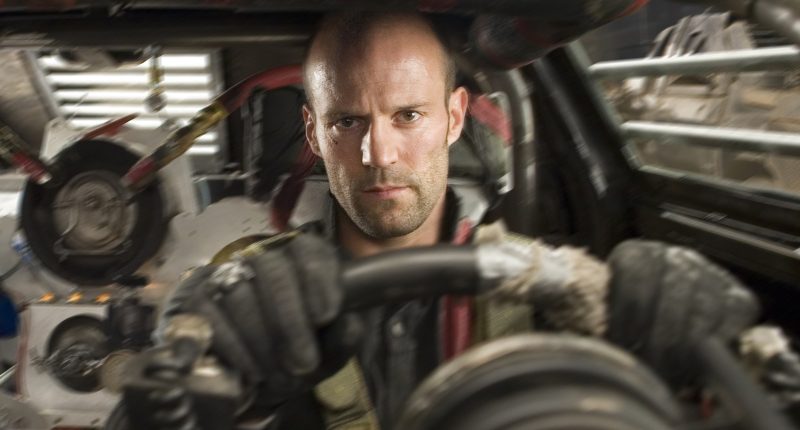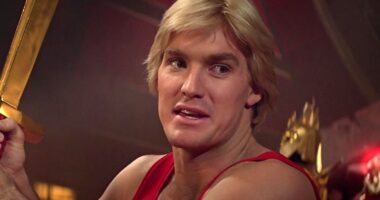Share this @internewscast.com
In the landscape of car racing films, the “Fast and Furious” movies undoubtedly hold a top spot for many, but they are not the only contenders in this genre. Before Dom and his crew were racing across the globe in souped-up sports cars, characters from another fictional realm were driving for much higher stakes.
The “Death Race” series might not be on the radar for those who aren’t avid fans of car culture or dystopian tales. It’s unfortunate because, despite its outrageous and exaggerated nature, the franchise boasts some of the most thrilling racing films ever made. Set in a world that resembles one from a cyberpunk novel, it depicts a society dominated by corporate control, where an appetite for brutal sports has resurfaced. Annually, the infamous race pits criminals against each other in deadly vehicular combat. Participants earn extra points for destroying opponents or running over bystanders, but ultimately, the race is won by whoever crosses the finish line first.
“Death Race” origins trace back to the 1970s, concurrently with series like “Mad Max” imagining bleak, vehicle-driven futures for humanity. Over more than five decades, the series has produced only six films, offering two distinct fictional universes and a complex timeline that could require a graphing calculator to trace. For die-hard fans seeking full immersion, here’s the chronological order for watching:
- “Death Race 2000” (1975)
- “Death Race” (2008)
- “Death Race 2” (2010)
- “Death Race 3: Inferno” (2013)
- “Death Race 2050” (2017)
- “Death Race: Beyond Anarchy” (2018)
Death Race 2000 (1975)
Released in 1975, “Death Race 2000” is part of a proud tradition of apocalyptic sci-fi movies that envision a future where humanity is utterly obsessed with cars. Unlike the “Mad Max” franchise, however, the people in “Death Race 2000” aren’t seeking out fuel and fresh wheels as a means of keeping themselves alive. Instead, the story is set in the distant future of 2000, where society keeps itself entertained by watching the Transcontinental Road Race. The massive sporting event is one part NASCAR and one part violent bumper cars as competitors race each other to the finish line while scoring points by damaging other vehicles and murdering pedestrians with their vehicles.
Directed by Paul Bartel and produced by Richard Corman, “Death Race 2000” is both the best and worst place to dive into the franchise. On the one hand, the movie is legitimately fun and well-made. It boasts an 82% rating on Rotten Tomatoes, making it one of the only movies in the series to impress critics. Plus, it has some memorable performances from actors like Sylvester Stallone and David Carradine.
On the other hand, this particular film will set a high bar that, depending on your personal preferences, the majority of the franchise will likely fail to live up to. But whether or not you start with this movie, “Death Race 2000” is absolutely worth watching if you’re going to explore the series at all.
Death Race (2008)
One of the many things that people may not know about Jason Statham is that he’s a star in two separate car racing franchises. This is because, despite receiving modest critical acclaim and inspiring a cohort of fans, “Death Race 2000” didn’t get a follow-up film for more than a quarter century. By the time the series returned, the year 2000 had come and gone, so instead of a sequel, we got a remake simply titled “Death Race.” The story follows a champion racer known to his fans as Frankenstein (Statham), and the movie doesn’t hold back on explosive action and over-the-top vehicular manslaughter. Like the original film, the plot of “Death Race” follows a group of competitors duking it out for the glory of first place and the privilege of staying alive.
“Death Race” introduced its unique futuristic world to a whole new generation that hadn’t even been born when the first film debuted. But, in stark comparison to the original movie, critics were not impressed. The remake stands at just 41% on Rotten Tomatoes, with many reviewers taking issue with the movie’s lackluster plot and emphasis on mindless action sequences. That said, critical reception isn’t the only measure of a film’s success, and without 2008’s “Death Race,” there wouldn’t be much of a franchise at all. This movie immediately inspired several sequels that were released direct-to-video, and, suddenly, the “Death Race” franchise expanded massively.
Death Race 2 (2010)
Fans of 2008’s “Death Race” were thrilled to learn that the movie was getting a follow-up just two years later, but they were probably a little disappointed when they found out that the cast of the first film wouldn’t be returning. Instead, “Death Race 2” sets itself up as a prequel, telling the origin story of Jason Statham’s character from the first film. But standing in for Statham is Luke Goss, who plays the infamous Frankenstein, currently known as Carl Lucas. After murdering a police officer, Carl finds himself sentenced to life in prison, but rather than spending the rest of his days sitting in a cell, he’s forced to compete in the Death Race against other inmates for the entertainment of the rest of society.
“Death Race 2” tried to expand the franchise’s universe and offer a bit of a different perspective on the titular race itself. The movie also features appearances from some beloved actors like Danny Trejo, Ving Rhames, and Sean Bean. The fresh story, new cast of characters, and explosive-as-ever action unfortunately didn’t help the movie make more of an impression than its predecessor. “Death Race 2” scored just a 17% with critics on Rotten Tomatoes, kicking off the franchise’s direct-to-video era with a fizzle. The movie also set the direction for the subsequent sequels going forward; every future sequel, with one notable exception, continued to build on the prequel’s storyline, and no other “Death Race” movie was set after the events of the 2008 film.
Death Race 3: Inferno (2013)
In 2013, “Death Race 3: Inferno” continued the prequel story that was kicked off in “Death Race 2.” The new movie sees the return of Luke Goss’s Carl “Frankenstein” Lucas as well as several supporting cast members from “Death Race 2,” like Danny Trejo’s Goldberg.
Lucas is just one race away from winning his freedom, but the Death Race itself is going through a huge shake-up. The event’s owner has been forced to sell the rights to the race, and the entire production is being turned into a global franchise. A separate Death Race is established in South Africa, and the new owner has pulled Frankenstein into the race with the hope of bringing the former champion down a peg. Frankenstein and his fellow racers have new challenges to face in the desert, and no one is fully prepared for what will happen to them out on the road.
“Death Race 3” is intended to be the connective tissue between the 2008 remake and its sequel. The film rounds out Frankenstein’s origin story and gives fans a brand-new Death Race to watch, and, thanks to some increased stakes and delightfully silly action scenes, the film is quite a bit more entertaining than “Death Race 2.” The movie scored a 50% on Rotten Tomatoes, which may not seem like much to write home about, but at the time it was the best-received film in the series since “Death Race 2000.”
Death Race 2050 (2017)
What comes after a reboot and two prequels pretending to be sequels? The answer is “Death Race 2050,” which, naturally, is a direct sequel to the original 1975 film. Original “Death Race” producer Roger Corman returned to finally make a true successor to “Death Race 2000” that imagines a future even more grim and violent than the one that existed in the original film.
In the year 2050, the Death Race has come to serve a purpose besides pure entertainment: population control. With too many people and not enough work to go around, the United Corporations of America have infused the deadly race with new, AI-powered vehicles to make the death and destruction of non-racers even more rampant. The movie has all the action of the films from the rebooted universe, but it also emphasizes the satirical elements that made the 1975 film such a fan favorite. “2050” is about as campy as the “Death Race” movies get, but in spite of the silliness, the movie really manages to convey a message about American culture.
“Death Race 2050” marked a new high point for the series. For fans of the original film, this movie finally represents a return to form, but anyone who loved the more recent “Death Race” movies can still find plenty to enjoy here. On Rotten Tomatoes, “Death Race 2050” has an impressive 86% freshness rating, so, according to critics, it’s the best movie in the entire series.
Death Race: Beyond Anarchy (2018)
The year after “Death Race 2050” arrived, the franchise got another installment that shifts back in time and refocuses on the world established by the 2008 movie. “Death Race: Beyond Anarchy” is the last ride for franchise fans, though the movie once again puts a new actor behind the mask of Death Race champion Frankenstein. This time the iconic racer is played by Velislav Pavlov and voiced by Nolan North, and his story involves significantly less driving than fans are used to. A large portion of “Death Race: Beyond Anarchy” takes place within a private prison called the Sprawl, where a new warden is trying to outlaw the Death Race and destroy Frankenstein’s legacy.
Watching “Beyond Anarchy” can feel like a bit of a letdown, especially since it was released just a year after “Death Race 2050.” Though the movie features some familiar characters, it doesn’t do much to expand on their stories, and because there’s only a Death Race in the final act, it’s also light on the franchise’s main attraction. Unfortunately, “Beyond Anarchy” ends the series on a low note, but considering that “Death Race” once went dormant for over 25 years before making an explosive return, fans can always stay hopeful that another chapter will reinvigorate the series at some point in the future.
Why you shouldn’t watch Death Race in release order
Most of the time, if you’re going to get into a new series, you start at the beginning. There are plenty of film franchises with a plethora of sequels and spin-offs, after all, and, in general, watching them in release order is the best way to experience the stories they have to tell. That really isn’t the case with the “Death Race” franchise for one glaring reason: the series actually involves two completely separate film universes.
In one corner, we have “Death Race 2000” and its belated sequel, “Death Race 2050.” These two films, despite being separated by nearly 50 years, they both take place in the same fictional, gasoline-powered world and are meant to go together. In the other corner, we have the rest of the “Death Race” franchise. 2008’s “Death Race” has plenty of similarities to the original film, but it takes place in a completely separate universe. Its sequels and prequels essentially represent a different story entirely. If you watch the full series in release order, things aren’t going to fit together all that well, so it’s better to think of “Death Race” as two separate series and to pick where you should start from there.
The in-universe chronology of Death Race
Wrapping your head around the two different worlds that exist within the “Death Race” franchise is only half the battle, as the movies that take place in the universe of 2008’s “Death Race” present their own problem to new viewers. Those films tell the story of Frankenstein, but they do everything completely out of order.
In the 2000s, movies and movie series really loved playing around with time, and “Death Race” is no exception. The franchise is convoluted even by the standards of the “Fast and Furious” timeline. “Death Race 2” is technically the first story that takes place according to the in-universe chronology. After that comes “Death Race 3: Inferno,” with the events of “Death Race: Beyond Anarchy” occurring an indefinite amount of time after “Inferno.” From there, you’ve got to go back to the 2008 movie that inspired this leg of the story to see how Frankenstein’s story ends. If you start with 2008’s “Death Race,” you’ll know Frankenstein’s fate before you see how he became a famed racer. For some viewers, that might be the optimal experience, but we’d recommend that anyone determined to watch the entire series work through the prequels first.
How to check out the Death Race source material
Believe it or not, “Death Race 2000” actually has some literary inspirations. The movie was partially based on a short story called “The Racer,” written by Ib Melchior. Like the film, the story explores a futuristic America where unchecked violence and corporate greed run rampant. Melchior himself was more than just a sci-fi author; he was also a regular presence in Hollywood. Throughout the ’50s and ’60s, Melchior wrote screenplays and teleplays for all sorts of productions, and almost all of them had some kind of sci-fi or horror element to them.
The “Death Race” franchise is fairly niche, and the same can be said for Melchior’s stories. Fans of the movies have gathered online to try and hunt down copies of “The Racer,” which can be incredibly difficult to find. With some careful work on Google, a dedicated fan might be able to track it down online, but it’s most commonly found in collections of Melchior’s writings or various sci-fi short story anthologies.
“Death Race 2000” and “Death Race 2050” have more in common with Melchior’s short story, especially in terms of tone, than the other movies in the series, but anyone who’s a fan of “Death Race” in any capacity would probably get a kick out of reading the story that inspired it all.
What’s the best way to watch the Death Race franchise?
There’s no such thing as the definitive “right way” to watch a movie series, but that isn’t going to stop us from giving a recommendation. If you want to watch some of the best car movies around, then “Death Race 2000” and “Death Race 2050” are the duo for you. That’s a recommendation, but we aren’t the real authorities here. Roger Corman, the producer who created the original “Death Race 2000” and its only true sequel, is much closer to being a real expert.
Corman has some serious respect for all the “Death Race” movies, including those he didn’t have a hand in, but he thinks they focus a little too much on the action and not enough on the subtext. Corman told LA Weekly, “The $200 million pictures don’t have a deeper meaning, because the studio must play it somewhat safe.” He went on to add, “This is why independent or lower-budget films can afford to take chances to be revolutionary.”
Corman’s “Death Race” movies may or may not be revolutionary, but they’re definitely the best in the series. So if you’re someone who needs to see things to completion, then here’s how to watch the “Death Race” movies in chronological order while saving the best the series has to offer for last:
- “Death Race 2” (2010)
- “Death Race 3: Inferno” (2013)
- “Death Race: Beyond Anarchy” (2018)
- “Death Race” (2008)
- “Death Race 2000” (1975)
- “Death Race 2050” (2017)









